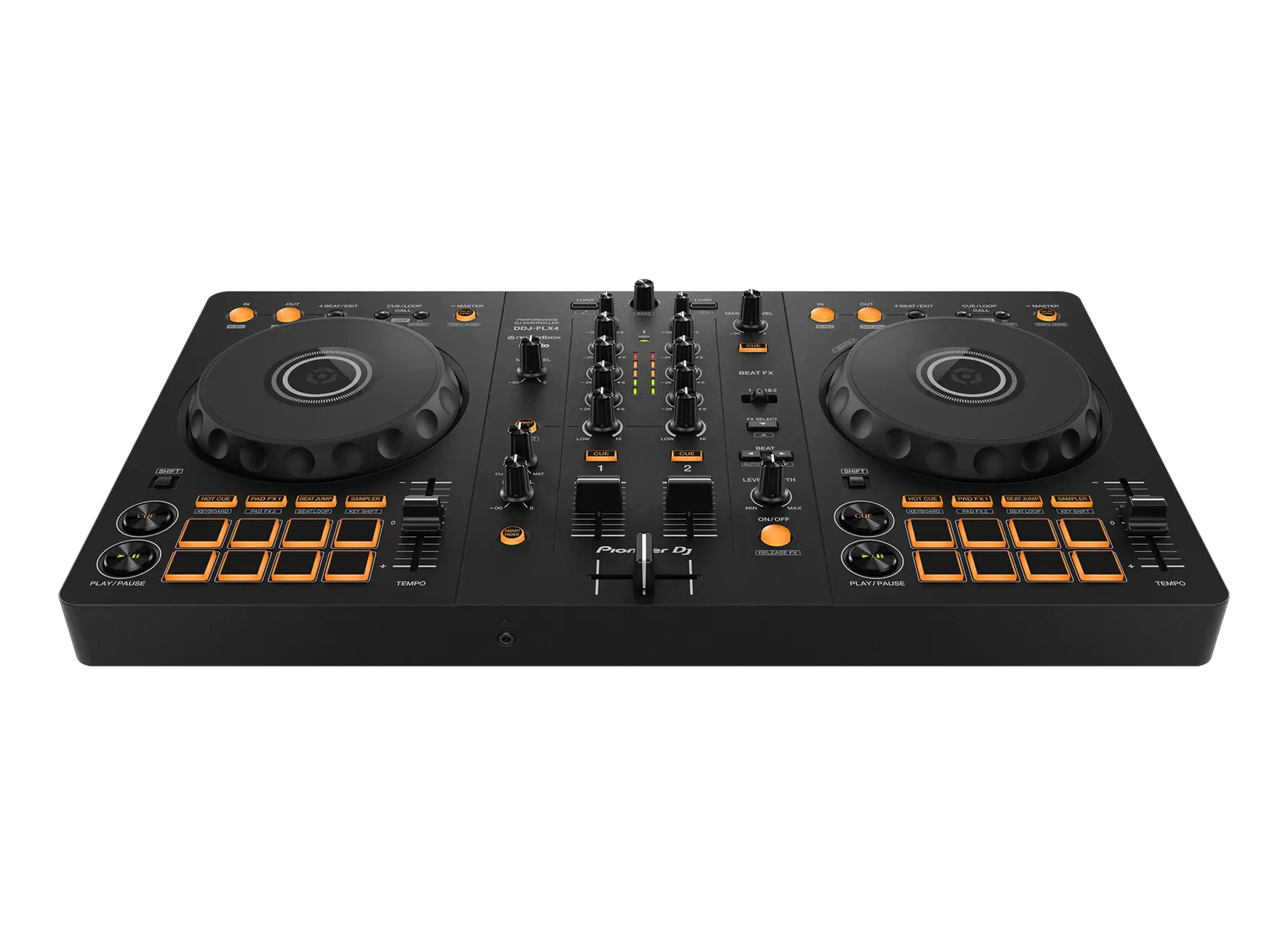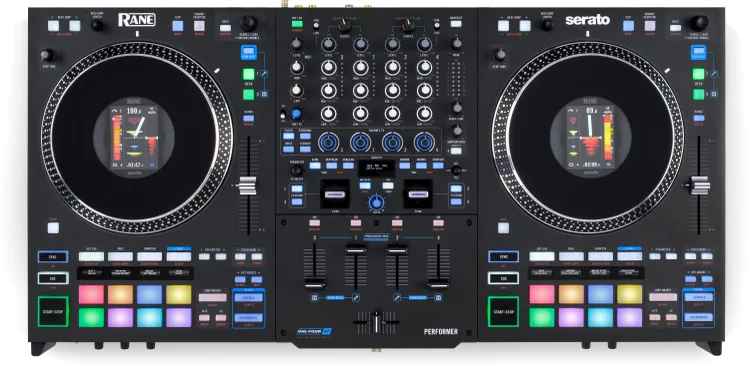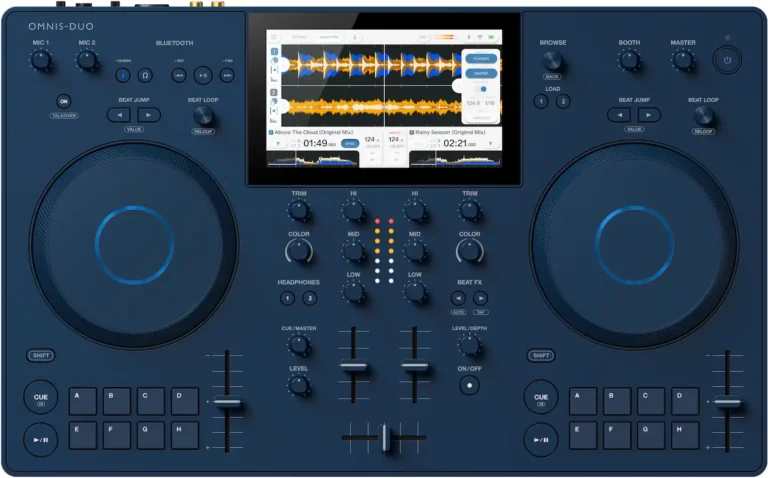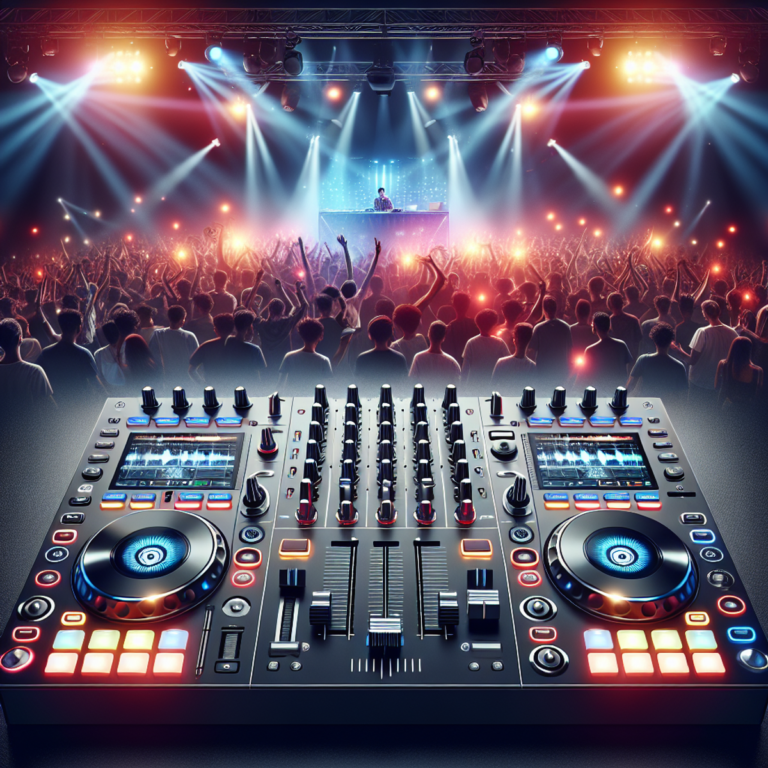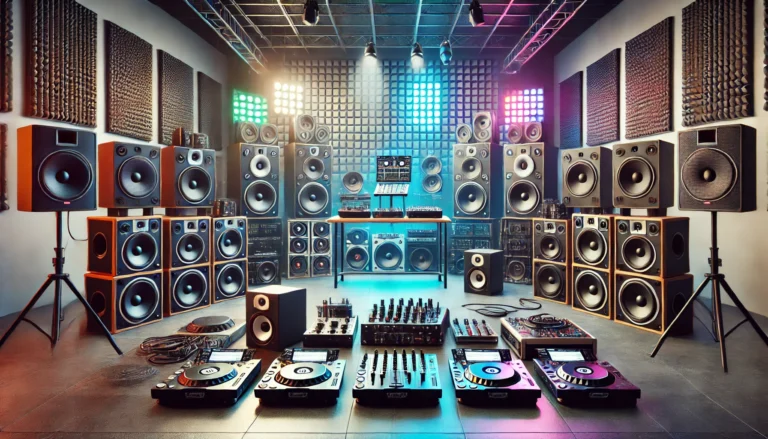Pioneer DJ DDJ-FLX4: The New Standard in Entry-Level Controllers
FIRST IMPRESSIONS & SETTING UP
The Pioneer DJ DDJ-FLX4 is the successor to the much-loved DDJ-400, and it retains many of the features that made its predecessor a hit. This is a good thing: the DDJ-400 was a highly popular controller, perfectly balancing functionality and affordability. Thankfully, the DDJ-FLX4 doesn’t take inspiration from the less cohesive DDJ-FLX6, which felt like a collection of mismatched ideas.
The DDJ-FLX4 is a straightforward two-channel controller with a simplified mixer section that still echoes Pioneer DJ’s high-end mixers. It features basic but effective jogwheels (without lights or displays), two sets of eight one-color “clicky” rubberized performance pads, and Pioneer DJ’s familiar loop, library, and level controls.
The design closely resembles the DDJ-400, with a few notable improvements. The plastic casing now has rounded corners, and the controller boasts a dark grey color scheme instead of black. The jogwheels have an attractive matte finish, and apart from two new buttons (which we’ll discuss shortly), the overall look is strikingly similar.
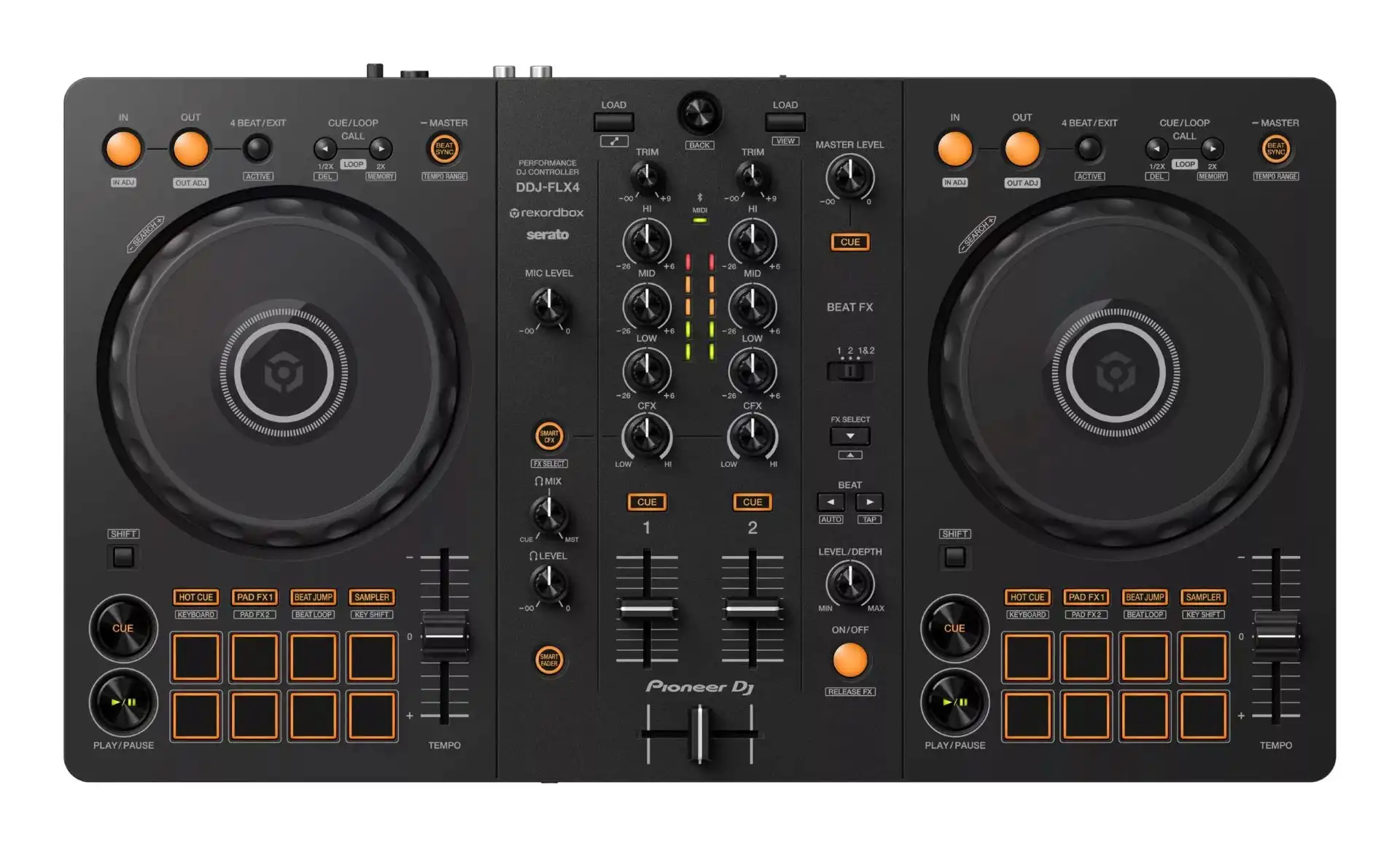
At the back, the controller is now powered via USB-C, with two sockets—one for power and one for a computer interface. However, it’s typically bus-powered, so you won’t need to worry about the power input unless you also want to charge a mobile device.
Speaking of mobile devices, the DDJ-FLX4 now supports Rekordbox on iOS and Android (coming early 2023), in addition to working with Rekordbox and Serato on Windows and Mac. This flexibility is a significant step forward, allowing you to DJ using your phone, Android tablet, or iPad.
Another useful feature for live streaming is that the mic input routes through the USB to your computer. This means your mic will be audible on streams or recordings without needing an extra mixer, which was a limitation of the DDJ-400.
Setting up the DDJ-FLX4 is simple. Plug it into your laptop, download the free Rekordbox or Serato DJ Lite app, and either add your music to the software or log into a streaming service like TIDAL, SoundCloud Go+, Beatport Streaming, or Beatsource Streaming. Connect some latency-free speakers, and you’re ready to go.
DDJ-FLX4 IN USE
The DDJ-FLX4 performs similarly to the DDJ-400, with a few enhancements. It’s not a “pro” controller (it’s smaller, more compact, and lacks some advanced features), but it’s highly functional and user-friendly. DJ and producer James Hype, known for his high-energy performances, frequently uses the DDJ-400, demonstrating its capability even in demanding scenarios.
The sound quality is solid for its price range, and the headphones are adequately loud for a bus-powered unit. The basic DJ features are all present, including three-band EQ, gain controls per channel, deck VUs (though no master VUs), a functional Beat FX strip, and two new beginner-friendly features.
Smart CFX
The Smart CFX feature transforms the knobs under the three-band EQs from simple filters to one-knob macro FX when engaged. This combines multiple effects to create combinations that would be challenging to achieve otherwise. Some effects cut the music, while others enhance it, offering fun and impactful options for build-ups and dramatic moments.
Holding down Smart CFX along with the Shift button allows you to cycle through a range of effects in your DJ software. These effects sound good and are a lot of fun to use, making them great for beginners and DJs who enjoy experimenting with effects.
Smart Fader
Smart Fader is a feature that will divide opinions, but it’s undeniably cool. When engaged, your crossfader becomes an almost foolproof tool for blending any two songs, regardless of genre or BPM.
Here’s how it works: activate Smart Fader, start your new song (the unit ensures it’s “on the beat”), and slowly move the crossfader. The unit syncs the tracks and adjusts the BPM to match, gradually transitioning the BPM from the old track to the new one as you move the fader. Simultaneously, it drops the bass on the old track and adds a bit of echo for a smooth transition.
It’s a clever way to simplify blending and make transitions smoother without much effort. While some purists may scoff at its simplicity, it’s a great feature for fun, stress-free DJing and can be a valuable learning tool for beginners.
ALTERNATIVES
1. Numark Mixtrack Platinum FX
Key Features:
- Four-deck capability: Allows for more complex mixing.
- Jog wheel displays: Provide information on track position, BPM, and more.
- Performance pads: Offer a range of functionalities including hot cues, auto loops, and samples.
- Dedicated FX section: With toggle switches for quick and easy effects manipulation.
- Built-in sound card: Simplifies setup and provides good audio quality.
Pros:
- Excellent for beginners with intuitive controls.
- Affordable price point.
- Lightweight and portable.
Cons:
- Jog wheels are not as responsive as some higher-end models.
- Limited effects compared to more advanced controllers.
2. Hercules DJControl Inpulse 500
Key Features:
- Intelligent Music Assistant (IMA): Helps beginners choose tracks that go well together.
- Beatmatch Guide: Light guides to help learn beatmatching.
- Dual USB ports: For easy switching between two laptops.
- Robust build: Metal backing plate for durability.
- Versatile connectivity: Outputs for professional sound systems and booth monitoring.
Pros:
- Great for learning DJ basics with helpful visual aids.
- Sturdy build quality.
- Comprehensive feature set for the price.
Cons:
- Software options (DJUCED and Serato DJ Lite) may not be as advanced as others.
- Slightly less intuitive for experienced DJs.
3. Roland DJ-202
Key Features:
- Built-in drum machine: Derived from Roland’s classic TR-808 and TR-909.
- Serato DJ Lite included: With upgrade path to Serato DJ Pro.
- Compact and lightweight: Easy to transport.
- Performance pads: For hot cues, loops, and samples.
- Dedicated transport controls: For easy track navigation.
Pros:
- Unique drum machine feature for added creativity.
- Good build quality and portability.
- Affordable and beginner-friendly.
Cons:
- Lacks the professional feel of more expensive controllers.
- Limited effects options compared to higher-end models.
4. Denon DJ Prime GO
Key Features:
- Standalone operation: No laptop required.
- Rechargeable battery: Offers up to 4 hours of operation.
- Wi-Fi streaming: Access to streaming services like TIDAL and Beatport.
- 7-inch touchscreen: For intuitive control and navigation.
- Professional-grade build: Durable and reliable.
Pros:
- Standalone capability is a major advantage.
- Highly portable with a built-in battery.
- Excellent build quality and advanced features.
Cons:
- Higher price point compared to other entry-level controllers.
- Learning curve may be steeper for complete beginners.
5. Native Instruments Traktor Kontrol S2 MK3
Key Features:
- Traktor Pro 3 software included: Known for its powerful features and stability.
- Large jog wheels: For precise control.
- Mixer FX: One-touch control over filters and effects.
- Compact and portable: Easy to carry to gigs.
- High-resolution displays: Show essential track information.
Pros:
- Seamless integration with Traktor Pro software.
- High build quality and responsive controls.
- Compact size with professional features.
Cons:
- Traktor Pro 3 may have a steeper learning curve.
- Limited to two decks.
CONCLUSION
With the release of the DDJ-FLX4, Pioneer DJ has effectively retired the DDJ-400 and introduced a new standard for entry-level DJ controllers. The DDJ-FLX4 supports multiple major software platforms (including the recently added Virtual DJ), works with a range of devices from phones and tablets to Macs and Windows PCs, and excels at all the basics.
The addition of new features like Smart CFX and Smart Fader, along with livestream mic support, makes it an even more attractive option. It combines the best aspects of the DDJ-200 and DDJ-400, while avoiding the pitfalls of the DDJ-FLX6.
In summary, the DDJ-FLX4 is a fantastic entry-level controller that offers great value for money, making it an excellent choice for beginners and seasoned DJs alike. Pioneer DJ has once again set the benchmark with a unit that’s likely to dominate the entry-level market for years to come.
Features
| Item Weight | 1 pounds |
| Product Dimensions | 10.74 x 18.98 x 2.33 inches |
| Country of Origin | Malaysia |
| ASIN | B0BK25SY9G |
| Item model number | DDJ-FLX4 |
| Date First Available | October 21, 2022 |
| Color Name | Graphite |
- 2-deck DJ Controller with Multi-device Compatibility
- USB Audio Output - Graphite
- Streaming Integration
- Smart Mixing

